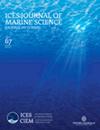Impacts on population indices if scientific surveys are excluded from marine protected areas
IF 3.4
2区 农林科学
Q1 FISHERIES
引用次数: 0
Abstract
Marine protected areas (MPAs) are increasingly common worldwide, typically restricting fishing activities. However, MPAs may also limit scientific surveys that impact benthic habitat. We combine a historical data degradation approach and simulation to investigate the effects on population indices of excluding surveys from MPAs. Our approach quantifies losses in precision, inter-annual accuracy, trend accuracy, and power to detect trends, as well as correlates of these effects. We apply this approach to a proposed MPA network off western Canada, examining 43 groundfish species observed by four surveys. Survey exclusion particularly impacted less precise indices, species well-represented in MPAs, and those whose density shifted in or out of MPAs. Redistributing survey effort outside MPAs consistently improved precision but not accuracy or trend detection—sometimes making estimates more precise about the ‘wrong’ index. While these changes may not qualitatively alter stock assessment for many species, in some cases, ∼30 percentage point reductions in power to detect simulated 50% population declines suggest meaningful impacts are possible. If survey restrictions continue expanding, index integrity could further degrade, eventually compromising the management of exploited populations. Regulating surveys within MPA boundaries therefore requires careful consideration to balance MPA objectives with the need for reliable monitoring.如果科学调查被排除在海洋保护区之外,对种群指数的影响
海洋保护区(MPA)在全球范围内越来越常见,通常限制捕鱼活动。然而,海洋保护区也可能限制影响底栖生物栖息地的科学调查。我们将历史数据退化方法与模拟相结合,研究将调查排除在海洋保护区之外对种群指数的影响。我们的方法量化了精度、年际精度、趋势精度和趋势检测能力的损失,以及这些影响的相关因素。我们将这种方法应用于加拿大西部沿海的一个拟议 MPA 网络,研究了四次调查观测到的 43 种底层鱼类。调查排除尤其影响了不太精确的指数、在 MPA 中代表性较高的物种以及密度在 MPA 内或外发生变化的物种。在海洋保护区外重新分配调查工作始终能提高精确度,但不能提高准确度或趋势检测--有时会使 "错误 "指数的估算更加精确。虽然这些变化可能不会对许多物种的种群评估产生质的改变,但在某些情况下,对模拟的 50%种群下降的检测能力降低了 30 个百分点,这表明可能会产生有意义的影响。如果调查限制继续扩大,指数完整性可能会进一步下降,最终影响对已开发种群的管理。因此,在MPA范围内规范调查需要谨慎考虑,以平衡MPA目标与可靠监测的需求。
本文章由计算机程序翻译,如有差异,请以英文原文为准。
求助全文
约1分钟内获得全文
求助全文
来源期刊

ICES Journal of Marine Science
农林科学-海洋学
CiteScore
6.60
自引率
12.10%
发文量
207
审稿时长
6-16 weeks
期刊介绍:
The ICES Journal of Marine Science publishes original articles, opinion essays (“Food for Thought”), visions for the future (“Quo Vadimus”), and critical reviews that contribute to our scientific understanding of marine systems and the impact of human activities on them. The Journal also serves as a foundation for scientific advice across the broad spectrum of management and conservation issues related to the marine environment. Oceanography (e.g. productivity-determining processes), marine habitats, living resources, and related topics constitute the key elements of papers considered for publication. This includes economic, social, and public administration studies to the extent that they are directly related to management of the seas and are of general interest to marine scientists. Integrated studies that bridge gaps between traditional disciplines are particularly welcome.
 求助内容:
求助内容: 应助结果提醒方式:
应助结果提醒方式:


